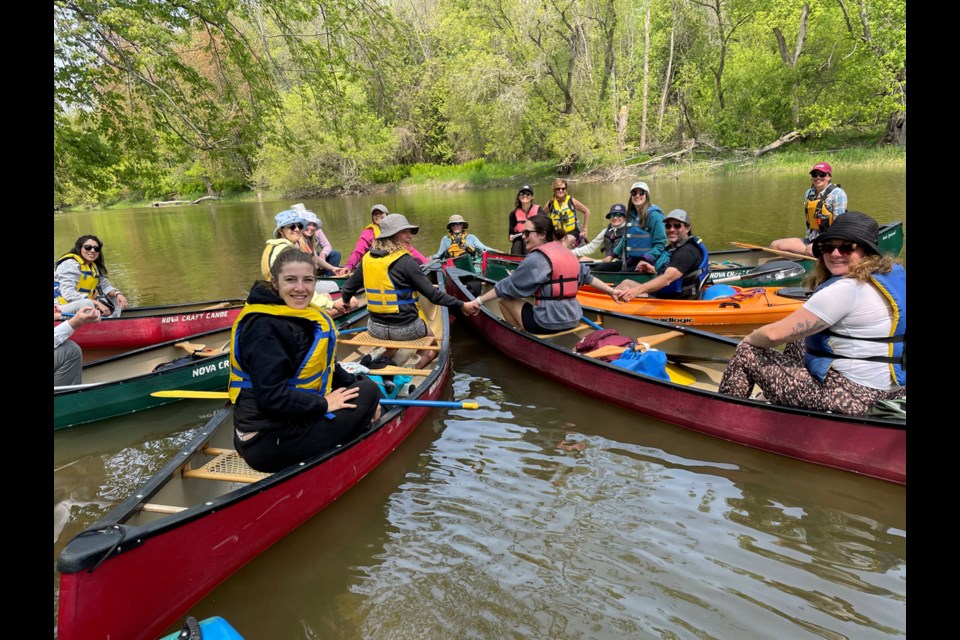How many local residents know where Chief Yellowhead is buried, or the location of Simcoe County’s historic Nine-Mile Portage, the meaning of the word Nottawasaga, or that our local water has been rated as some of the best in the world?
These are just a few of the facts that students enrolled in Lakehead University’s unique “Place-Based Education” course have been learning over the past two weeks as they explore the local area by bike, canoe and in hiking boots. I joined a group of 14 students on day eight of the ten-day course of study as they explored waterways of the region.
The course is part of Lakehead’s Faculty of Education program and was created by Assistant Professor Dr. Gary Pluim, who is committed to teaching students, above all else, about the place where they are and the land they come from. His students are enrolled in the university’s Bachelor of Education, Concurrent Education or Master of Education programs.
“We need to know our own place,” explained Pluim. “Education should be rooted in an understanding of where we are in the world. Many of us don’t know about all the species, waterways, and complex histories of our region. So, it is vital for our upcoming teachers to ground themselves in a knowledge of their place."
Six years ago, when Pluim pitched a new course focused on this “place-based” concept of learning, he thought about what he would most like to do. As someone who loves the outdoors and is an avid cyclist, paddler and runner, it’s not surprising that what Pluim came up with was an adventurous two-week program where students explore the Orillia and Simcoe County area by biking, paddling and hiking.
The intensive course requires extraordinary logistics and is offered every two or three years.
“In this course, we learn about the ecology, history, and geography of the region, with a focus on how environment shapes the culture of the societies that have lived here,” said Pluim.
Beginning in Orillia, the students are introduced to the waters, the land, and the ancestors of the region as they travel a counter-clockwise loop through the region that takes them on historical routes, each day providing a new set of insights.
Along the way, students meet with Indigenous leaders, museum curators, teachers and others who help to explain significant landmarks and uncover the stories that have shaped the place where they live and study.
The day I joined the group, the adventure was to paddle the historic Nottawasaga River. Each day’s activities begin with a discussion circle where students share insights from the previous day and are given an overview of the day’s objectives.
On this day, the students would learn about the history of the river as well as hear presentations related to the local ecosystem. One student presented her findings on the meaning of the word Nottawasaga, which led to an interesting discussion related to recommendations in the Truth and Reconciliation Report.
“What we’re learning in this course is helping to de-colonize our mindset,” agreed the students.
“What I love about the course is how we’re developing community,” said Kaitlyn Lampic. “We’re learning from each other as well as from some amazing resource people. There are so many perspectives on how to connect with and understand the land. Gary has created this by being such a collaborative leader and teacher.”
Karen Whitehorn, who is auditing the course as a community member, also found the course to be not only a challenging adventure, but an eye-opening experience.
“We’re seeing the world in a different way,” said Whitehorn. This course has broadened my perspective on so many levels — historically, philosophically and intellectually. On the first day my eyes were opened; then I began to hear new things; and now I feel my voice has changed.”
The students have also experienced the benefits, not to mention the fun and adventure, of exploring by non-motorized travel.
“We’re learning the joy of place-based learning,” said student, James Mitchell. “There’s so much that can distract us from the natural world around us. Exploring this way has given us the power to really connect to the places we live.”
“This is everything I enjoy doing,” said Jenna Skof. “It’s experiential learning, a better way to learn and more memorable.”
Her canoe partner, Lindsay Sargent, added.
“You know, people travel all over the world to find adventure and learn about history. We have it all right here. We’re learning about a 5,000-year-old history right in our backyards," said Sargent.
By providing such a unique in-depth study of the region’s Indigenous and settler histories, patterns of colonization, geographic features and environmental characteristics, Pluim is certainly developing a strong foundation of place among these future educators. And their contribution is not lost on their perceptive teacher.
At the day’s wrap-up circle discussion, Pluim expressed both encouragement and gratitude to students.
“This course can be broken down into ‘what?, so what?, and now what?.’ Right now we’re getting into the ‘now what’, so it’s time to carry forward your insight and learning to others.”
Pluim concluded by reinforcing his emphasis on collaboration. “Thank you everyone for sharing such brilliant insights.”



